By: Syed Zafar Mehdi

One day in Paris, during Imam Khomeini's exile, there was an important phone call from Tehran. It was Dr. Syed Mohammad Hosseini Beheshti on the line, Imam’s close aide and the martyr of Haft Tir tragedy.
“For Imam's reception, we have arranged an elaborate program. Tell Imam that we will roll carpet at the airport, decorate it with lights, and the parade will pass from Mehrabad Airport to Behesht-e-Zahra by helicopter,” he told Firdousi Pur, who was in charge of Imam's office in Paris.
When Firdousi Pur informed Imam about it, he listened carefully and with a characteristic grin said: “Go and tell the men that they are not welcoming Cyrus to Iran. This is not necessary at all! A student has left Iran and the same student is returning to Iran. I want to be among my people and go with them, even if I get trampled upon.”
The flight back home after 14 years in exile was unarguably the most important journey undertaken by the founder of the Islamic revolution. All eyes were on him and his arrival in Tehran, even as nationwide protests against the Pahlavi regime and confrontation between protestors and military forces raged on.
Before heading home, Imam issued a brief statement thanking the French government. “I leave your country to go and serve my country,” read the note.
Two weeks prior to Imam’s triumphant homecoming, West-backed despotic ruler Reza Shah Pahlavi had fled the country, appointing his lackey Shahpour Bakhtiar as the head of caretaker regime. The popular uprising in Iran against the Pahlavi regime had forced Pahlavi to escape.
On board a chartered Air France Boeing 747, Imam sat quietly, surrounded by his close aides, a bunch of journalists and younger son Ahmad Khomeini.
Peter Jennings, a Canadian-American journalist who anchored a prime time show on ABC World News, asked him: “What do you feel?” Imam answered: “Nothing!” He asked again, the answer was same.
In that “nothing”, Imam said everything. That one-word answer reflected his extraordinary strength of character. Lack of emotions at that important moment signified that Imam sought nearness to Allah rather than nearness to the grandeur of world, power and fiefdom. He detached ‘self’ from his endeavors and sought pleasure of the ‘ultimate power’ above all powers.
On February 1, 1979, Imam touched down at the Mehrabad Airport in Tehran, ending his long exile. The packed airport reverberated with ‘Allah is great’ and ‘Khomeini is our leader’ slogans.
“We are succeeding, but this is only the first stage,” Imam told his ecstatic supporters who had turned up at the airport to welcome him. “The movement will be successful only when the roots of colonialism are pulled out,” he added, referring to the Pahlavi regime backed by the U.S.
The success of the revolution, he said, was the result of the unity of all Iranians, irrespective of their religious beliefs. Among those who had come to welcome Imam at the airport were representatives of the Armenian and Assyrian churches.
During the flight from Paris to Tehran, Imam had told journalists accompanying him that he would announce his own provisional government and the nationwide protests would be called off if Bakhtair agrees to resign.
The morning Imam arrived, millions of people poured into streets across the country to welcome him. They chanted vociferous slogans in support of the Islamic revolution and against the Pahlavi monarchy.
Upon landing in Tehran, Imam drove straight to Behesht e Zahra (sa) cemetery in south Tehran to pay his respects to the martyrs of revolution. The visibly jubilant followers lined the one mile stretch from the airport to the city’s largest cemetery.
In his first address, he offered his condolences to the parents of martyrs and vowed to uphold the principles of resistance and resilience against the forces of evil. He denounced the interim government led by Bakhtiar and asked him to abdicate power immediately.
“I must tell you that Mohammad Reza Pahlavi, that evil traitor, has gone. This man, his government, his Majlis are all illegal. If they were to continue to stay in power, we would treat them as criminals and would try them as criminals,” Imam declared.
Imam soon announced formation of a new government with Mahdi Bazargan as the prime minister, forcing Pahlavi’s lackey Bakhtiar to escape. His regime collapsed on February 11, ten days after the arrival of Imam.
Thus the West-backed Pahlavi monarchy crumbled and the Islamic revolution became a great success story. The overthrow of Pahlavi regime was followed by the takeover of U.S. embassy in Tehran.
In Pahlavi's disgraceful downfall, Americans lost an important ally in the region and they lost their grip over Iran. They continue to hold that grudge. Hence the bullying, saber-rattling and sanctions. Iranians stood unfazed then, they stand unfazed now.
Imam’s legacy continues to guide the proud Iranian nation and his worthy predecessor Imam Khamenei has followed on the same path, refusing to surrender before the so-called ‘superpowers’ of the world despite enormous pressure.
Imam's socio-political ideology was deeply rooted in Islam. In Kashaf-ul-Asrar, he said religion is the “only thing that dissuades mankind from treachery and crime”.
“Unfortunately, those who take the helm of affairs in Iran have either a false faith or no faith at all (referring to Shah's regime of that time). These demagogues who speak fervently of safeguarding the interests of the country actually look after their own interests,” he wrote.

No comments:
Post a Comment